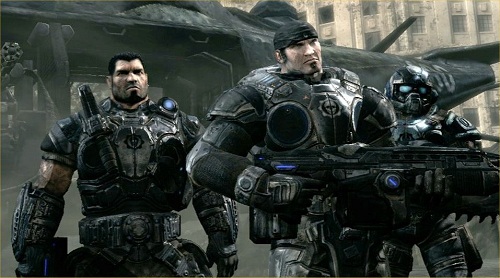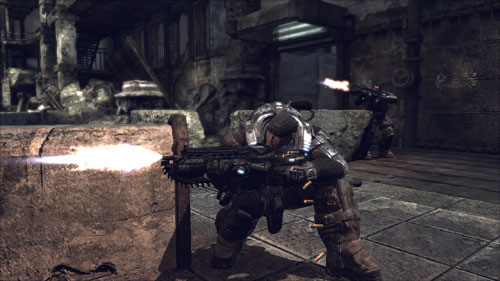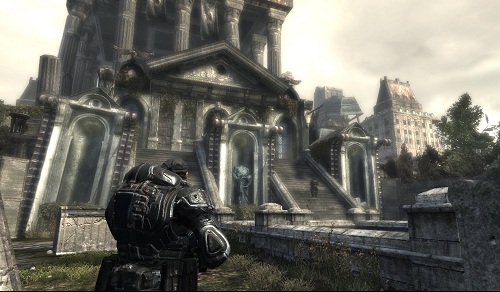With Epic Games’ Gears of War 3 right around the corner, it’s now a good time to look back at where it all began, with Gears of War, originally released in November of 2006. This is the game where Marcus Fenix and the Locust plight were first introduced to the world, and the success this game achieved is undeniable.
But why has this franchise become as popular as it is today? If you’ve played Gears of War, you will know immediately why. If you’ve somehow never played, or never even heard of Gears of War, then this review is for you. Gears fans, consider this review a helpful refresher course as you prepare for the launch of Gears of War 3.

Gears of War takes place on the planet of Sera, where all was well until Emergence Day. This day marked the beginning of the Locust’s attack on humanity, which forced the Coalition of Ordered Governments (better known as COG) to instill martial law and fight the Locust. As you can probably imagine, the humans live on the surface of the planet, while the Locust reside underground, emerging to the surface through holes. These holes can occur anywhere and anytime, much to the advantage of the Locust.
Players control Marcus Fenix, a former COG soldier, who begins the game in prison. However, Marcus is forced back into service, as a desperate humanity releases all their prisoners to help fight the Locust.
While the premise of Gears of War will certainly keep the player interested, it’s the gameplay that will keep them coming back. You control Marcus from an over-the-shoulder camera angle, much inspired by Resident Evil 4. The controls here are standard for shooting games, but the “A” button has multiple features. A quick tap of the button while holding any direction on the control stick will cause Marcus to dive in that direction, while holding down “A” and pressing forward will result in a “roadie run,” where Marcus crouches and sprints, with the camera shaking to give the appearance of fast speed.
However, the “A” button’s primary feature is the cover system. When near a wall, the game will prompt you to press “A” to dive into cover. Nearly every battle must be fought while in cover, as Marcus is highly vulnerable to damage from bullets (especially on the Insane difficulty level). Taking cover also gives the player the chance to regenerate health. The controls are spot-on in terms of accuracy, and I was always caught up in the experience, never having to look down at the controller, as the controls become second nature.

The combat itself is intense and satisfying. Thanks to stellar sound effects, you can hear each bullet impacting itself into your target, while at the same time hearing bullets zip past you. The amount of targets on screen is impressive, and you will often be fired upon at all angles, strategizing which wall will provide the best cover.
The gun selection is limited, with only two of the weapons being the standouts (this is resolved in Gears of War 2, with its expanded arsenal of weapons). The gun that I find myself using at least 90% of the time is the Lancer machine gun. It’s a standard machine gun with a large clip, but what really sets this gun apart from the rest is the addition of a chainsaw attachment for melee kills. For close kills, walk up to an enemy while revving up the chainsaw with the “B” button, and watch an extremely satisfying cutscene as your character impales the chainsaw into the enemy, with blood splattering and coating the camera.
The other standout weapon is the Hammer of Dawn. Choose your target, and a satellite orbiting the planet will fire a laser onto the spot that you chose. This weapon is used for larger enemies, but it can also be satisfying to use it on large groups of smaller enemies. The Hammer of Dawn is definitely unique, and I can’t think of any similar guns in other games.

Reloading your weapons can be a challenge in itself. By tapping the Right Bumper, a mechanic known as “Active Reload” ensues. A progress bar appears on the top right corner of the screen, with a tiny portion of it colored white. A cursor scrolls to the right by itself, and you must stop this cursor in the white area by pressing the Right Bumper again. Doing so successfully will result in a fast reload with more powerful bullets. Miss the white area, however, and you will be subjected to a long reload time, with normal bullets. This mechanic provides a fresh experience on the standard reload action, and provides more depth during battles. It is difficult to successfully pull off an Active Reload at first, but with a little practice, you will be nailing them with regularity.
Gears of War features multiplayer, but with only four modes, and all of them being variations of the standard deathmatch, the multiplayer did not really appeal to me. It didn't really bring anything new to the table, even back when it was originally released. What I found frustrating is, if two players are running towards each other with chainsaws revved, the game will randomly choose a winner of that duel. Thankfully, this is fixed in Gears of War 2, where players locked in a chainsaw duel can frantically tap “B,” and the player who taps “B” the fastest wins the duel. As a side note, multiplayer is improved in Gears of War 2 with the addition of the Horde mode, but more on that in that game’s review.
Gears of War is an excellent first addition to the franchise, and it provided a formula that many other games tried to follow, but couldn’t sucessfully capture. It was obvious from the ending scene that there would be a follow-up to the game, and not surprisingly, Gears of War 2 was released two years later. Stay tuned for our retro review of the sequel.